Planetarium Trouble - Star Ball Not Getting Power
May 16, 2016
This page is to collect what Karl (my former LIA and also retired director of the De Anza Planetarium) and I learned on this issue. I'd come in for a planetarium show on May 8 and found the star ball would not power up. The rest of the controls worked OK. I got through the show with just slides. Didn't take a bright-lit look at the star ball because of tight schedule then, but got hold of Karl who wanted to come out and we'd both try to diagnose and fix the trouble on May 16. Here's what we learned...
First thing I noticed was that it looked like someone had launched a cup of coffee or perhaps cola up onto the StarBall. None had leaked into the insides where the lamp is, but can't rule out that this was related to the failure of the StarBall. First thing I checked was the back of the console panel, and saw that a wire had come off the fuse to the StarBall. I figured this was the problem, but reconnecting the wire by hand did not solve it. I went down and bought a new 3A fast-blow fuse and holder and Karl and I soldered
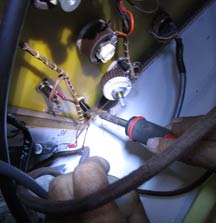
1. Soldering the errant wire onto the new fuse holder
|
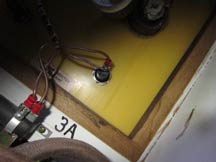
2. The new fuse, in place. Turning on the power to the starball did not blow the fuse. The old fuse, strangly, couldn't be pulled from it's holder so no conclusion on whether it was blown or not.
|
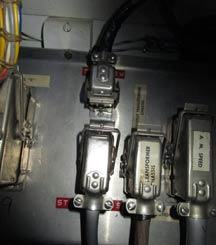
3. Next downstream was to check the connectors which take controls to the star ball (motor, power to the lamp, etc.). All the copper contacts looked perfect. Clean, no damage or corrosion. That's true on both the lower and upper one, centered in the photo above |
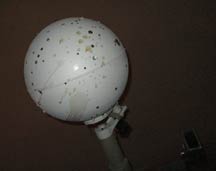
4. The brown liquid stains on the StarBall. Cola? Coffee? I got my nose up to it but couldn't get a scent. It was sticky, but cleaned up with a damp cloth. Didn't see any other physical damage.
The liquid clearly didn't come from dripping through the ceiling or anywhere else I could find. It looked like it had come from someone tossing a cup's worth up onto the ball from below. But since the door is locked and no one should have the key, except Karl and the janitors, it's not clear how this happened.
|
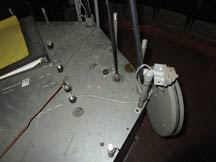
5. Stains on the base below. Not good. Why and where did these come from? I suspect foul play.
|
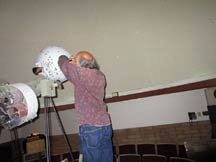
So, we checked for voltage coming in to the StarBall xenon lamp. Just a few tenths of a volt. Not good. No power getting to the lamp. We did not take the lamp out of its holder, but there was no evidence of electrical shorting or arcing or any burnt smell. It looked instead like the power wasn't getting in to the lamp and the problem was back upstream.
|
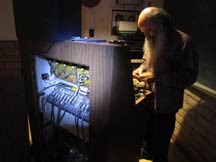
6. So, we powered up, including the star ball, in order to evaluate the power supply to the star ball.
|
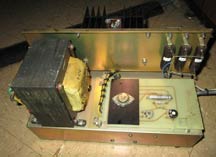
7. The StarBall power supply. Looks like it generates high voltage to power the xenon lamp. Pretty beefy transformer and power transistor. |
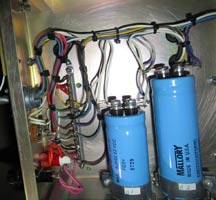
8. The components on the underside all looked fine. Nothing looked or smelled "blown" and the wires all looked good.
|
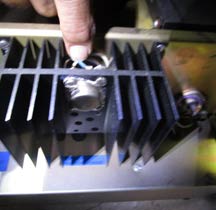
9. The power transistor mounted on the big heat sink did indeed get too warm to the touch when we powered up. So the power supply is getting power. |
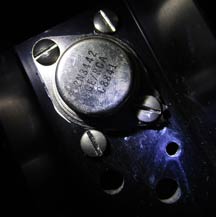
10. Here's the spec's on the power transistor
|
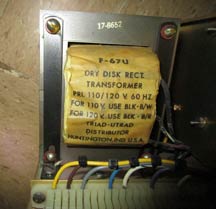
11. The beefy transformer on the power supply. Note the 1500 VAC wire. All looked fine, no damage or burned places. However, when we powered up, the transformer did not do any 60hz vibration nor did its temperature go up even a tiny bit.
|
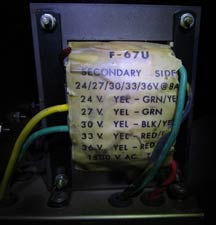
12. The other side of the transformer |
|
|
|
So the bottom line for now - we can't find any definite electrical damage points. However, Karl thought one of the wires out of the back of the power supply power transistor felt looser than it should be. While the power transistor still got hot, perhaps it's slightly intermittent? We also opened the door to the pit below, but saw no wires in there which related to anything but the motor which raises, lowers the projector. The key which opens the back panel of the console also opens the pit door.
Karl and I don't know how to test the power supply individual components for integrity beyond the simple things, so our next step is to hand it over to our crack electronics troubleshooter - Astro clubber par exellence Tom Trumbull, who's got a lot of experience testing these old-style electronic circuits.
May 28, 2017
Update; Tom's done some tests. Turns out the voltage to the rectifier from the power transistor is flakey... In Tom's emails...
"I will try to power up the power supply and measure its output voltage. I have some large wattage 8 ohm resistors that I can strap onto the output to see if the voltage remains constant under a load. I believe the DC voltage is around 40v and the power supply is good for 10amps that is 400 watts. 40v/8 ohms will equal 5amps. That should be safe and tell us if the power supply is functioning as expected.
After powering up the power supply, I started measuring voltages without a load for I am not sure which pins go to the projector lamp, and found that the one side of the bridge rectifier has unstable voltage. I started wiggling the loss wire on the transistor that Karl was talking about and it makes the voltage change. I took out the transistor again and wiggled the wire and it broke off the holder. I will replace this socket and see if this makes the voltage stable. I will let you know as soon as I have completed the fix".












